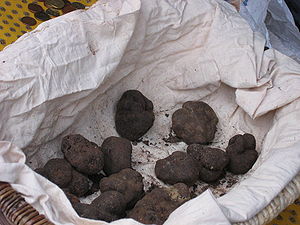For our part, we avoid buying each other presents or cards and instead focus on having a lovely, romantic day. Though we have dined out in the past we now prefer to cook at home, making a meal that is decadent and fun. Decadent does not have to mean environmentally unhealthy, however, especially when you live in an area that produces truffles which some believe rival the Italian. Both black and white truffles grow abundantly in Oregon and Northern California, and though they are quite expensive the flavor is phenomenal and unique. Wild scallops, which have been unsustainable in the past, have seen massive increases in population size recently, and most sources now say that scallops can be fished sustainably and are okay for environmentalists to eat (though if you can find out the info, individually caught is better than dredged).
Valentine's Day Dinner
It is important for us to use every excuse to spend time with and honor the people we love, regardless of whether the excuse is tradition or Hallmark made. The way we do this, however, is up to us and not the card companies or the traditions. Cooking a meal made from the best available local and sustainable ingredients instead of purchasing cards and chocolate boxes and dining out turns our expression of our love for each other into a reinforcement of the way we choose to live. And personally I think it is more fun. Speaking of fun, for desert we made a chocolate Fondue, dipping homemade donut pieces from that morning along with some fancy marshmallows
Our Valentine's Breakfast
So, for your scrutiny, here is the dinner recipe:
Wild Scallops with Black Truffle Brandy Reduction and Mashed Great Northern Beans
Serves Two
 Image via Wikipedia
Image via WikipediaIngredients:
1 small Black Truffle (~1/2 oz.)
6 medium to large Wild Scallops (~1/2 lbs.)
1/2 lbs Dry Great Northern Beans (or Cannellini)
1 large Shallot
3 oz VSOP Brandy
2 tbsp dry White Wine
6 tbsp Olive Oil
4 tbsp butter
1 Green Onion, finely chopped
The night before cooking, rinse the beans and visually inspect for rocks. Cover the beans with water in a sauce pan and leave to soak overnight. The following day, discard the soaking liquid and rinse the beans once more. Cover with water and bring to a boil, then reduce to a simmer and cook until beans are tender, about 1 hour.
Chop the black truffle very finely. Alternatively, you can use a mandolin, cheese grater or vegetable peeler to get smaller and more regular pieces. Melt 2 tbsp butter into 2 tbsp olive oil in a small pan, and add the truffle. Simmer over a low heat until well browned. This will mellow the funkiness of the black truffle and draw out its flavor (this step is not necessary with white truffles). When truffle pieces are well browned, cover and keep nearby.
When the beans are done, drain the cooking liquid, reserving about a half cup. Using a food processor or blender, mash the beans with 1 tbsp olive oil, the white wine, 1 oz of Brandy, and a pinch of salt and pepper. If needed, add the cooking liquid a little at a time to control consistency. When beans are well blended, return to the sauce pan and keep warm over a low heat.
Dice the shallot finely and brown in 1 tbsp olive oil. When it is well browned, add it to the beans along with half of the black truffle and oil mixture, stirring well.
Sear the scallops over medium-high heat in 2 tbsp olive oil, about 5 minutes per side. When scallops are finished, place them on a bed of the mashed beans on serving plates. Quickly deglaze the pan with the remaining 2 oz of brandy, add the remaining truffle and oil mixture, remove from heat and stir the remaining 2 tbsp of butter to finish the pan sauce. Pour the sauce over the scallops and mashed beans, garnish with green onion, serve immediately.
The Final Product













